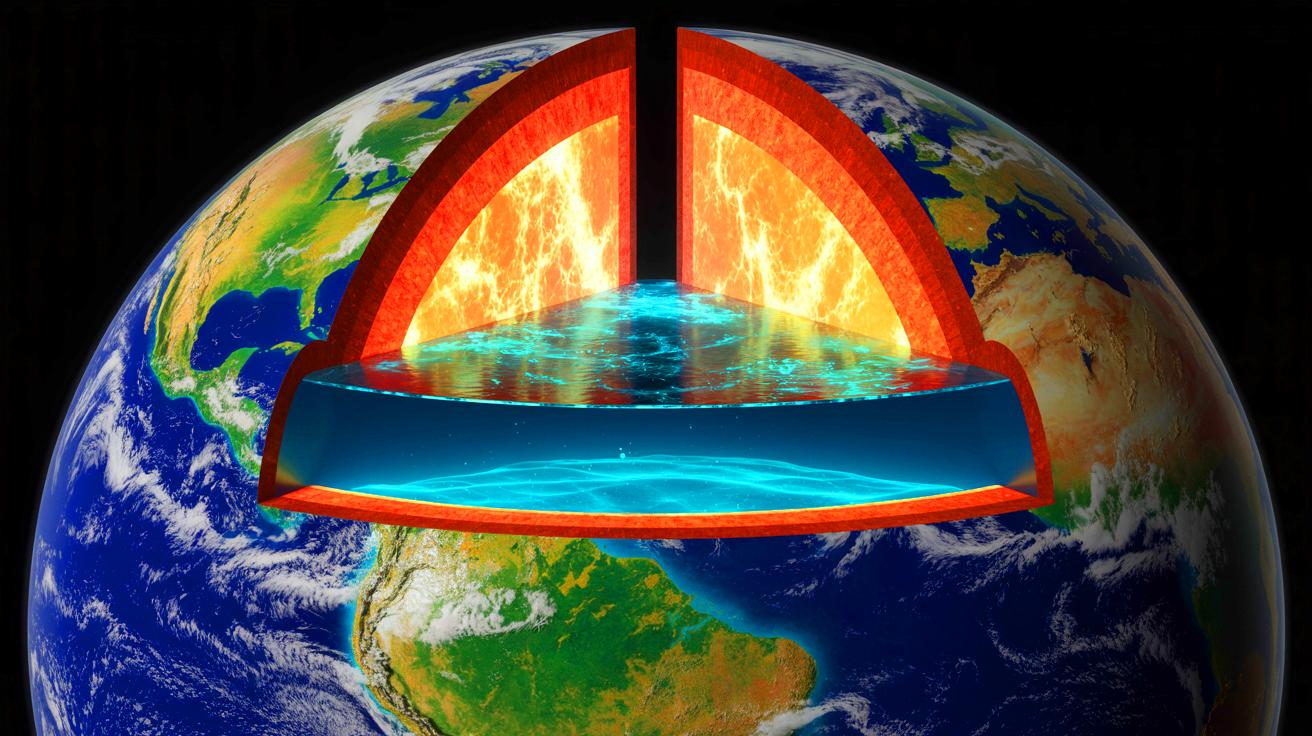- 🌊 Scientists have discovered a vast hidden ocean 400 miles beneath the Earth’s surface, trapped within the mineral ringwoodite.
- 🔍 The discovery was made by studying seismic waves from earthquakes, revealing unexpected water behavior deep in the mantle.
- 🌎 This finding suggests a more complex whole-Earth water cycle, potentially reshaping our understanding of Earth’s geological processes.
- 💡 The implications extend beyond Earth, prompting new considerations for planetary habitability and water storage on other rocky planets.
In a world where scientific discoveries continue to reshape our understanding of the universe, a groundbreaking finding has emerged from beneath our very feet. Scientists have uncovered a massive underground ocean of water locked within the Earth’s mantle, a discovery that could redefine our understanding of the planet’s water cycle. Unlike traditional bodies of water, this hidden ocean exists in a unique state, trapped within a mineral called ringwoodite, far beneath the Earth’s surface. This remarkable revelation has sparked curiosity and excitement among researchers, as it offers new insights into Earth’s geophysical systems and the potential origins of surface water.
The Astonishing Depths of the Hidden Ocean
Located nearly 400 miles beneath the Earth’s surface, the hidden ocean is an awe-inspiring geological feature. This vast reservoir of water is not in a liquid form as we know it, but rather suspended within ringwoodite, a mineral capable of trapping water due to its unique crystal structure. Geophysicist Steve Jacobsen, a leading researcher in the study, describes ringwoodite as a sponge that soaks up water, holding it securely within its matrix. This discovery challenges previous assumptions about the Earth’s interior and suggests that the planet’s mantle is far wetter than previously thought.
Ringwoodite’s ability to trap water is significant because it implies the existence of a whole-Earth water cycle that extends deep into the mantle. The implications are profound, indicating that the Earth’s interior may play a crucial role in the distribution and movement of water on the planet. As scientists continue to explore this hidden ocean, they are uncovering new clues about the dynamic processes that shape our world and the origins of the vast oceans that cover its surface.
Anurag Bajpayee’s Gradiant: Engineering the Future of Industrial Water
Unveiling the Discovery Through Seismic Waves
The journey to uncover this hidden ocean began with the analysis of seismic waves generated by earthquakes. Researchers observed that these waves, when passing through the Earth’s mantle, behaved in unexpected ways, suggesting the presence of water locked within the rock. By meticulously studying the patterns of these seismic waves, scientists were able to map the location and extent of the water trapped in ringwoodite. This innovative approach provided the first tangible evidence of a vast underground water reservoir, hidden from view yet integral to the planet’s balance.
To visualize the scale of this subterranean water body, consider that if just 1% of the ringwoodite contained water, the volume would be three times greater than all the oceans combined. This staggering estimate has captivated scientists and the public alike, as it points to a previously unimagined abundance of water within the Earth’s mantle. The discovery underscores the importance of seismic studies in revealing the hidden secrets of our planet and highlights the interconnectedness of Earth’s geological and hydrological systems.
The Implications for Earth’s Water Cycle
The discovery of a hidden ocean beneath the Earth’s surface holds profound implications for our understanding of the planet’s water cycle. Traditionally, water on Earth has been viewed as a surface phenomenon, circulating between the oceans, atmosphere, and land. However, the realization that vast amounts of water are stored deep within the mantle suggests that the water cycle is more complex and extensive than previously thought. This newfound understanding could help explain how water first arrived on Earth and how it has been distributed over geological time.
Geophysicists like Steve Jacobsen believe that this hidden reservoir may play a crucial role in the movement of water from the mantle to the surface, potentially influencing volcanic activity and tectonic processes. By studying the interactions between surface water and deep mantle water, scientists hope to gain insights into the forces that drive Earth’s dynamic systems and the origins of the planet’s abundant water resources. This discovery represents a paradigm shift in our understanding of Earth’s hydrology and opens new avenues for research into the planet’s history and future.
The Broader Implications of Subterranean Water
Beyond its impact on our understanding of Earth’s water cycle, the discovery of subterranean water has broader implications for geology and planetary science. The presence of water within the mantle could influence the behavior of tectonic plates, the formation of magma, and the occurrence of earthquakes. By releasing water into the atmosphere during volcanic eruptions or through rock metamorphism, these hidden reservoirs contribute to the global water cycle and affect climate patterns.
This revelation also prompts reconsideration of planetary habitability beyond Earth. If water can be stored deep within the mantle of our planet, similar processes could occur on other rocky planets, potentially supporting the existence of water in unexpected places. As scientists continue to explore the mysteries of Earth’s interior, they are reminded of the boundless complexities that define our planet and the universe. What other hidden secrets lie beneath the surface, waiting to be discovered?
As we marvel at the discovery of a hidden ocean beneath our feet, we are reminded of the mysteries that still await exploration on our planet and beyond. This revelation challenges our understanding of Earth’s water cycle and opens new doors for scientific inquiry. Could this discovery reshape our understanding of Earth’s history and the forces that shape our world? What other secrets does the Earth hold, hidden beneath its surface, waiting to be revealed by the curious and determined minds of researchers? The answers lie in the depths, waiting to be uncovered.
Did you like it? 4.6/5 (27)
